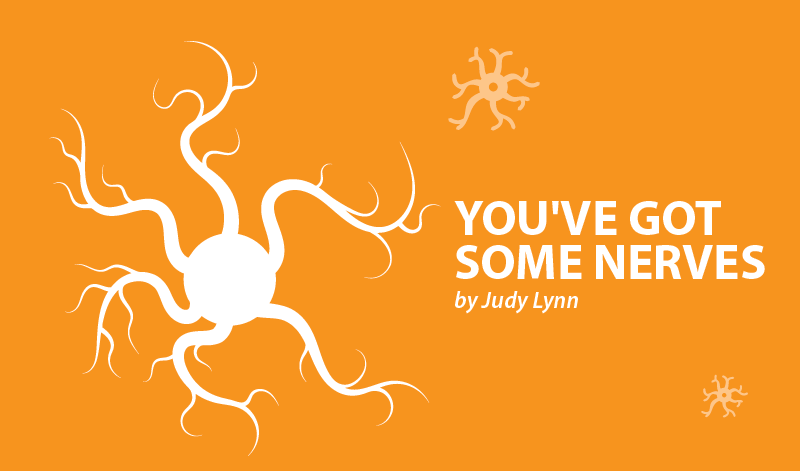Is MS Pain Giving You Ants in Your Pants and Bees in Your Bonnet?


It took two years and many doctors to finally receive my MS diagnosis. Frequent painful sensations, such as burning, itching, stabbing, and tingling in my arm and shoulder, led my providers and me on a wild-goose chase in search of other problems. When my speech and balance were affected I finally received an MRI of my brain, rather than my shoulder. I was told that MS didn’t usually cause pain.
Painful sensations, known as dysesthesias, are more common in MS than once thought. A 2016 National MS Society Clinical Bulletin titled, “Pain in Multiple Sclerosis,” states, “A recent systematic review of the literature, pooling all studies of pain … indicated MS pain prevalence rates of 63%.” This type of neuropathic pain is associated with demyelination in the central nervous system. There may not be a structural cause, but the body perceives pain when signals misfire between the brain or spinal cord and one’s extremities. Like an electrical system, the protective coating of the wires (myelin, in our case) is worn away, which causes short-circuits and impulse disruptions.
The Clinical Bulletin explains that dysesthesias appear in two categories:
- Intermittent central neuropathic pain is spontaneous, sudden, violent, and is typically characterized as shooting, stabbing, shock-like, lancinating, crushing or searing.
- Continuous central neuropathic pain is characterized as burning, tingling, aching, throbbing, vice- or band-like.
While the latter is not generally as painful as the intermittent form, it can have a greater impact on a person’s quality of life due to its constant presence. It may be worse at night, with activity or changes in temperature. My fire ants often graduate to bees that sting my arm, chest, and shoulder if I push myself too hard in hot weather. I have learned to add extra medication before outings on hot days. Much like an actual insect sting, it is better to prevent the pain than deal with the aftereffects.
Fortunately, there are treatment options. The bulletin points out that, “Dysesthetic pain is difficult to treat fully.” However, I encourage MS patients to keep trying. If we must have ants in our pants and bees in our bonnets, we can bug our healthcare providers until we get some relief!
Medication treatment options (listed in the bulletin)
- Tricyclic antidepressants.
- Serotonin-noradrenaline reuptake inhibitors.
- Antiepileptic drugs such as gabapentin.
- Lidocaine patches, capsaicin patches, and tramadol.
- Strong opioids and botulinum toxin.
- Cannabinoids were not recommended, however, that may be due to adverse effects, rather than lack of efficacy.
Non-pharmacologic treatments
- Treatment by a pain psychologist.
- Behavioral self-management; relaxation training, cognitive-talk therapy, adaptive coping, etc.
- Social activities like a painting class or hippotherapy.
- Physical activity like yoga, tai chi, or aquatic exercises.
- Counter-irritation such as massage, the use of heat or cold, acupuncture, and reflexology.
- Mindfulness and meditation.
- Guided imagery, breathing, and progressive relaxation.
Clinicians are encouraged to evaluate pain at each clinical encounter and:
- Recognize and treat comorbidities and psychological factors of anxiety and depression.
- Enhance social factors of support and a trusting provider relationship.
- Use medications that target pain mechanisms.
- Combine low doses of several medications for greater efficacy with fewer adverse events.
- Refer to integrative health and wellness practices.
Using low doses of multiple medications, physical activity, mindfulness, progressive relaxation, and other tools, I have days without pain. When the ants and bees invade, I take extra medication, curl up with a book or take a nap. I distract myself long enough for the worst to pass.
A 2007 article in ScienceDirect revealed that about “one-third of … patients with moderate pain and 18% of those with severe pain reported no consultations for their pain. The effects of pain severity were fully evident in the respondents’ daily life, their work, mood, recreational activities and enjoyment of life. … [T]he high prevalence of MS-related severe pain, low satisfaction with management of intense pain, and the perceived interference with quality of life indicators necessitate greater attention by healthcare providers to the management of pain and uncomfortable sensations in the MS population.”
If you struggle with dysesthesias, print out the Clinical Bulletin to discuss with your healthcare provider. Don’t let your pain get the best of you!
***
Note: Multiple Sclerosis News Today is strictly a news and information website about the disease. It does not provide medical advice, diagnosis, or treatment. This content is not intended to be a substitute for professional medical advice, diagnosis, or treatment. Always seek the advice of your physician or other qualified health provider with any questions you may have regarding a medical condition. Never disregard professional medical advice or delay in seeking it because of something you have read on this website. The opinions expressed in this column are not those of Multiple Sclerosis News Today, or its parent company, Bionews Services, and are intended to spark discussion about issues pertaining to multiple sclerosis.







Leave a comment
Fill in the required fields to post. Your email address will not be published.